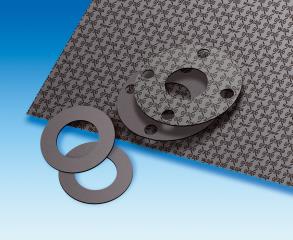High Performance Sheet Gasket
Made of ceramic fiber (super heat resisting inorganic fiber) and excellent in flexibility and high temperature heat resistance, these are used as various types of sealing materials, as well as heat insulating material, shielding material and protective material. Since a small amount of organic fiber is included in the manufacturing process, some amount of smoke is generated at the initial stage of heating, while No.105SN cloth and No.112SN ribbon (liver) are smoking prevention treated. As core material of cloth and ribbon yarn, stainless wire is normally used, but others include glass fiber.

- VALQUA No.
- GF300 (Food)
- Product name
- BLACK HYPER
- Features1
- This is a high-performance non-asbestos sheet gasket ideal for utility lines using water vapor and oil.
- Features2
- These comply with the Food Sanitation Law.
- Features3
- Products with PTFE as the binder have a longstanding issue in the creep relaxation property. This gasket has achieved a significant improvement in this area, with reliability for long-term use under high-temperatures. Please contact us if you are not satisfied with the reliability of other companies' products for long-term use under high temperatures.
Conforms to the Food Sanitation Act and standards for food and additives
- Applicable fluid
- Water, sea water, hot water, steam,Crude oil, alcohol, animal and vegetable oils, thermal oil,General solvents, weak acid, weak alkali,Air, nitrogen, inert gas,Exhaust gas,Flammable gas,Cryogenic fluid,
- Inappropriate fluid
- Oxidizing acid, Gas susceptible to burn lile oxygen, Polymerizable monomer, Strong alkali, Poisonous, Hydrofluoric acid
- Use
- Cover flanges, nozzles and other joints for pipe flanges, valve bonnets, towers and tanks, ovens, pressure vessels, and heat exchangers in factories, electric power plants, oil refineries, steel plants, and ships.
- Main component
- PTFE, Silica, Graphite
- Color / print
- Dark-grey/Black






